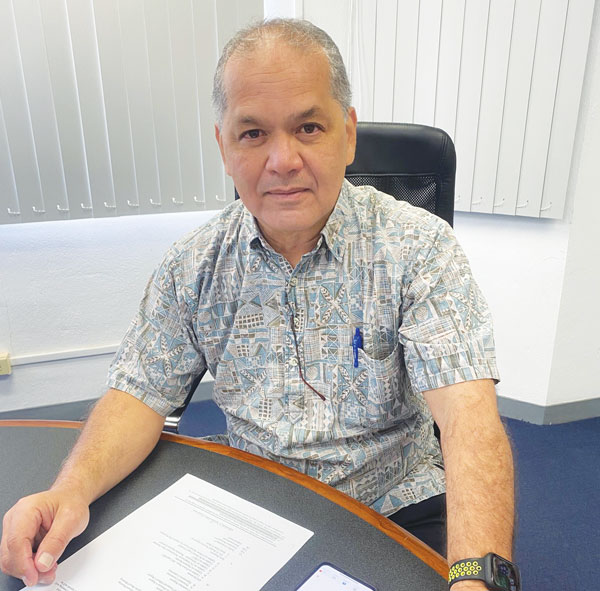Camacho: CUC’s renewable energy plan still in the works

CUC executive director Gary P. Camacho. (LEIGH GASES)
The Commonwealth Utilities Corp. will soon be doing an research study that will determine the type of power plant the islands of Saipan, Tinian and Rota will need, with a great emphasis on renewable energy, according to CUC executive director Gary P. Camacho.
He said the research study will be a comprehensive decision-support mechanism that creates a long-term roadmap using financial modeling and technical analysis to determine the best options for supplying electricity over the long run at the least possible cost on Saipan and Rota. It will be funded by the Northern Marianas Housing Corp. through the U.S. Department of Housing Urban Development.
Camacho said they want to continue to have these studies and review them to ensure that they acquire the latest technology and the most appropriate and efficient and effective equipment for the CNMI’s power supply, moving forward.
CUC already has an Integrated Resource Plan that was adopted in a board meeting last year. That Integrated Resource Plan, Camacho said, tells CUC to prepare a diesel power plant with 10 megawatts of solar power.
The upcoming study will tell CUC “the type of power plant, how much solar, or if wind is something to be considered, battery storage, or diesel, all of those are going to be studied and then provide us with the best-case scenarios and multiple different options,” added Camacho.
When asked if it’s possible for the CNMI to be on 100% renewable energy, Camacho said it is not possible. “Let’s just say you’ve got 10% of the island demand, which would be 3 megawatts because the peak demand is 3.7…so, 3% of 10% is three megawatts. …Then you have a cloud come over and you lose 10% of your demand. …When you lose 10%, something has to produce power, which is the power plant,” said Camacho. The change goes from renewable energy to power plant, and Camacho said that if this goes on all day it will hurt the engines.
Camacho said there are many factors that a system has to be prepared for to ensure that nothing is jeopardized. In any consideration for a new power plant, CUC is always looking for renewable energy. He added that they had an Integrated Resource Plan that was performed a while back, but now they have a new IRP that includes renewable energy. “We’re going to be designing our power platform with consultants and experts in the field, and we’re going to make it clear that we want to maximize renewable energies and expand our portfolio,” said Camacho. A new IRP needs to be done again because the study has a lifespan of about five to six years.
Camacho added that renewable energy is something he wants to prioritize, and that CUC is always interested in maximizing. “We’ve had a system that’s somewhat aged as far as production is concerned…so, we would just always work on ensuring that although we’ve been accepting renewables, we want to make sure that we have a system. It’s our responsibility to ensure that any penetration does not negatively impact our power supply,”
said Camacho.
When asked what Camacho thinks will happen as a result of the study, he said a “determination based on conditions, locations, seasons, and demand is a wide range but I’m excited because the new technologies that are available today and the advancements of old technologies, such as greater efficiency on diesel, greater efficiency on battery storage and greater efficiency on solar and wind. There’s wind towers that can be adjusted and brought down due to storms or tilted down.”
Lastly, he said there’s a variety of different things that will be determined in the study but the experts and consultants or any responsible qualified firm will be working closely with CUC and stakeholders on the type of power plant that will be built in the future. “At the end of that study, of course, will be a list of different types of options based on scoring. And we’ll go forward with that direction,” Camacho added.























